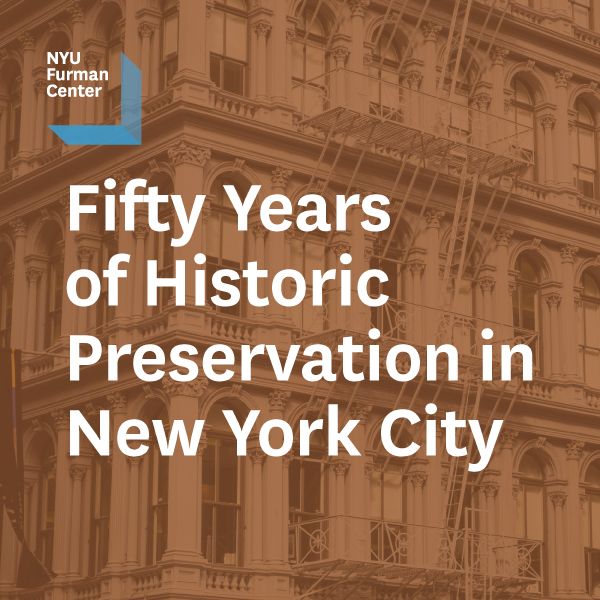
Fifty Years of Historic Preservation in New York City

The NYU Furman Center's latest report, Fifty Years of Historic Preservation in New York City, shows the extent of preservation across the city and compares the land use, housing stock, demographic characteristics, and commercial property in historic districts with those in areas that are not regulated by the city's Landmarks Preservation Commission.
The report finds that New York City’s historic districts have similar population and built density, a higher market-rate share of rental housing, and residents who are higher-income, more highly educated, and more likely to be white. Other key findings are summarized below.
The report is based on a white paper with the same title by Ingrid Gould Ellen, Brian J. McCabe, and Eric Stern.
BRIEFING: NYU Furman Center researchers will hold webinar briefing on the report findings on Tuesday, March 15, 2016 from 3:00-4:00pm EST. Advance registration is required.
For more, see the press release, read the policy brief, or read the white paper.
Summary of Key Findings
1. By 2014, city-wide just 3.4 percent of New York City lots were located inside an area covered by LPC designation, but a high concentration of Manhattan lots, 27 percent, were in a designated area.
- The corresponding lot coverage in other boroughs was 5.2 percent in Brooklyn, 3.2 percent in the Bronx, 3.1 percent in Staten Island, and 1.6 percent in Queens.
- Most historic districts are concentrated in just a few areas of New York City, including Manhattan south of 14th Street, the Upper East Side, the Upper West Side, the areas surrounding downtown Brooklyn, and Prospect Park.
2. On average, historic districts were as densely populated and had the same built density than other areas in the same community district.
- While historic district lots were generally built to the same density as other lots within their same community district, they tended to use up more of their development potential, as they were zoned, on average, to somewhat lower allowable density.
- On average, census tracts that were mostly included in a historic district had the same population density as tracts in the same community district that were fully outside of historic districts.
3. Historic districts saw fewer new buildings but similar alteration activity compared to nearby non-LPC-regulated areas.
- Within historic districts, six out of every 1,000 lots saw a new building constructed between 2004 and 2014, compared to 39 out of every 1,000 lots outside of historic districts.
- Lots in historic districts saw the same levels of officially recorded alteration activity between 2004 and 2014 as non-LPC-designated lots in the same community district.
4. Historic districts had a higher market-rate share of multifamily rental units than non-LPC-regulated areas.
- Within historic districts, 56.6 percent of multifamily rental units were market rate, as compared to 30.5 percent of rental units on lots unregulated by the LPC.
- Only 0.3 percent of total multifamily rental units in historic districts were public housing units, as compared to 12.1 percent of the rental stock not regulated by LPC.
- Only 2.7 percent of total rental units in historic districts were privately-owned, income restricted subsidized units, as compared to 10.5 percent of the rental stock not regulated by LPC.
- Rental units on the lots in designated areas were less likely to be rent-regulated, but were no more likely to exit rent regulation than other units in the same neighborhood.
5. Residents of historic districts were higher-income, more highly educated and more likely to be non-Hispanic white than residents of non-LPC-regulated areas.
- In Brooklyn and Manhattan, the mean income for households living in census tracts mostly inside a historic district was more than double households living in tracts fully outside of the historic district.
- In Brooklyn, 69 percent of adult residents in census tracts mostly included in historic districts held college degrees as compared to just 27 percent of those in tracts outside of districts.
- Citywide, 63 percent of residents of tracts mostly covered by a historic district were non-Hispanic white, compared with 30 percent in tracts not at all covered by a historic district.
Media contact: Shannon Moriarty, shannon.moriarty@nyu.edu


